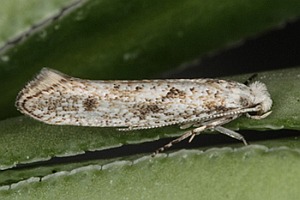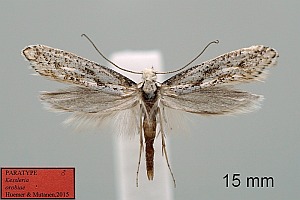2. Diagnose
2.1. Männchen
3. Biologie
3.1. Nahrung der Raupe
- [Saxifragaceae:] Saxifraga paniculata (Rispen-Steinbrech)
- [Saxifragaceae:] Saxifraga sp. (Steinbrech)
Huemer & Mutanen (2015) konnten berichten: "The larval habits are insufficiently known, but based on our observations, the larva lives in the shoots and as a leaf-miner in basal leaves of Saxifraga paniculata and Saxifraga sp. Mined leaves are partially spun together and covered with a fine silken web. The adults have been collected from the Saxifraga-cushions or nearby rock during the day. In the first few hours of the night they have been observed with a head-lamp flying actively around the larval habitat or sitting near the host-plant."
(Autor: Erwin Rennwald)
4. Weitere Informationen
4.1. Etymologie (Namenserklärung)
Die Art wird nach der Gegend des Typenfundortes benannt: "The species name refers to the Orobian Alps (Alpi Orobie) in northern Italy, where the type locality is situated" (Huemer & Mutanen 2015).
4.2. Faunistik
Die Art ist nur vom Typenfundort und wenigen benachbarten Lokalitäten bekannt: "Only known from Zambla Alta – Plassa and few nearby localities in the Orobian Alps (Prov. Bergamo, Italy)" (Huemer & Mutanen 2015).
4.3. Typenmaterial
Huemer & Mutanen (2015) schreiben zur Typenserie: "Holotype. ♂, „ITALIA sept. Prov. Bergamo, Alpi Orobie Zambla Alta – Plassa 9°47'48"E, 45°54'12"N 1160 m, 24.6.2013 leg. Huemer“ „DNA Barcode TLMF Lep 09972“ „YPO 160 ♂ P. Huemer“ (TLMF).
Paratypes. Italy: 6 ♂, 6 ♀, same data, DNA barcode IDs TLMF Lep 09971, TLMF Lep 09973 (TLMF); 1 ♂, 1 ♀, same data, but e.l. 11.7.2013 (TLMF); 7 ♂, 2 ♀, same data, but leg. Mayr (coll. Mayr, Feldkirch); 1 ♂, Prov. Bergamo, Alpi Orobie, Val d´Arera, 2000 m, 14.–15.8.1992, leg. Huemer (TLMF); 1 ♀, Prov. Bergamo, Alpi Orobie, W. Ca. San Marco, 2100 m, e.l. 31.7.1992, leg. Huemer & Tarmann, DNA barcode ID TLMF Lep 03175 (TLMF)."
(Autor: Erwin Rennwald)
4.4. Literatur
- Erstbeschreibung: Huemer, P. & M. Mutanen (2015): Alpha taxonomy of the genus Kessleria Nowicki, 1864, revisited in light of DNA-barcoding (Lepidoptera, Yponomeutidae). — ZooKeys 503: 89-133 (11 May 2015). doi: 10.3897/zookeys.503.9590. [Artikel auf zookeys.pensoft.net]







